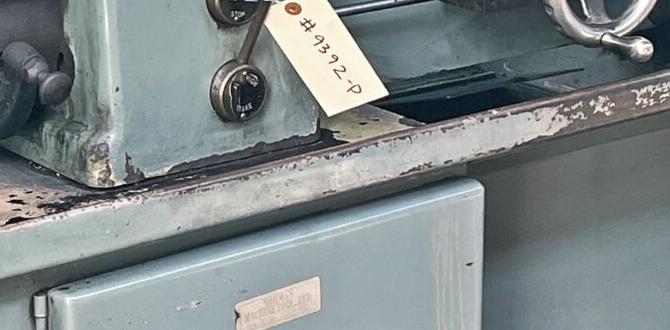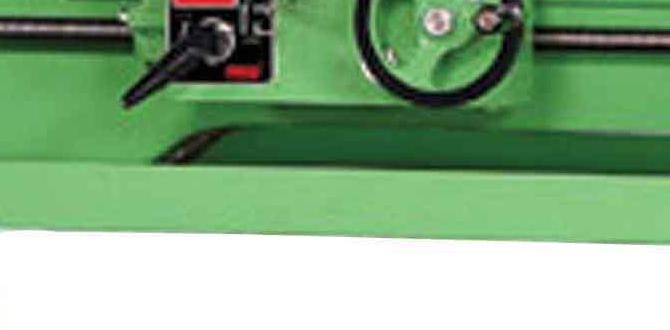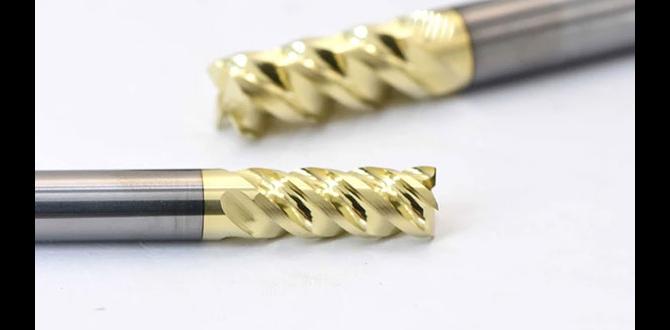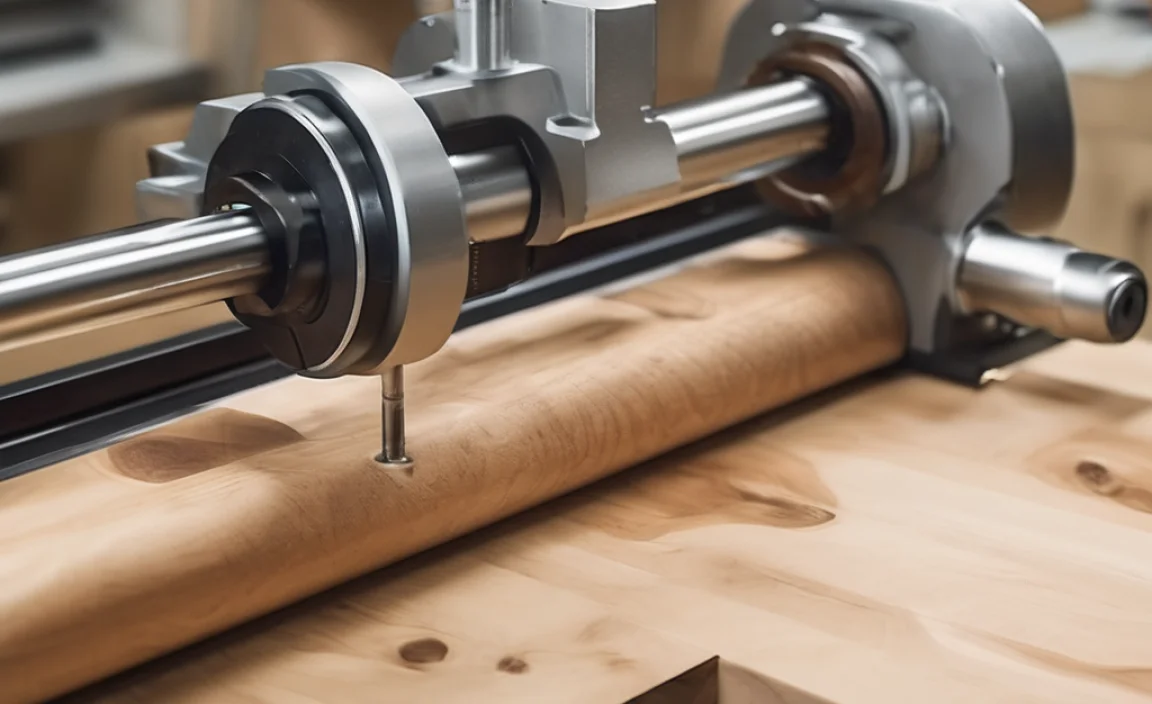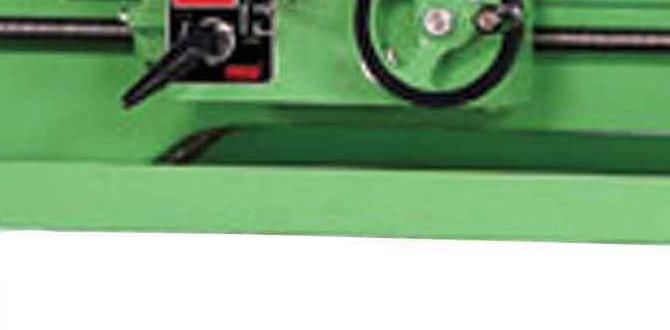This guide shows you how to create a homemade wood lathe tool sharpening kit, saving money and ensuring your woodturning tools stay sharp for clean, precise cuts. Learn the essential components and how to assemble a DIY kit perfect for beginners looking to maintain their tools effectively.
Ever found your wood lathe tools just not cutting like they used to? It’s a common frustration for woodturners, especially when you’re just starting out. Dull tools make beautiful projects incredibly difficult, leading to splintered wood, uneven finishes, and a lot more effort than necessary. The good news? You don’t need a fancy, expensive commercial kit to keep your chisels and gouges razor-sharp. You can easily build your own effective sharpening setup right in your workshop. This guide will walk you through exactly what you need and how to put together a fantastic homemade wood lathe tool sharpening kit that will transform your turning experience.
Why a Homemade Wood Lathe Tool Sharpening Kit is Essential
Keeping your wood lathe tools sharp is non-negotiable for enjoyable and successful woodturning. Sharp tools are safer, they perform better, and they make your work look professional. A dull tool requires more force to cut, which can lead to the tool kicking back, causing injury or damaging your workpiece. Beyond safety, sharp tools glide through the wood, allowing for smooth cuts, crisp details, and a superior finish, all while minimizing tear-out and the need for extensive sanding later.
Commercial sharpening kits can be quite costly, often including items you might not need or can easily replicate yourself. Building your own kit allows you to select high-quality components tailored to your specific needs and budget. It’s a practical, cost-effective solution that empowers you to take control of your tool maintenance. Plus, understanding the sharpening process yourself adds another layer of skill and confidence to your woodworking journey.
The Core Components of Your DIY Sharpening Kit
You don’t need a vast collection of specialized items to create a highly effective homemade wood lathe tool sharpening kit. The key is to have the right abrasive surfaces and a way to hold your tools at the correct angles. Here are the essential building blocks:
1. Abrasive Surfaces: The Heart of Sharpening
This is where the magic happens. You need materials that can grind away a small amount of metal to restore the cutting edge. For a beginner-friendly setup, focusing on two or three types of abrasives is usually sufficient.
- Sharpening Stones (Water Stones or Oil Stones): These are the classic choice for a reason.
- Water Stones: These are fast-cutting and produce a fine edge. They require soaking in water before use. Common grit combinations are 1000/6000 or 400/1000 grit. A 1000 grit stone is good for general sharpening, and a 4000-6000 grit stone is for refining the edge to a polished sharpness. You can find affordable combination stones from various manufacturers. Look for reputable brands known for quality abrasives.
- Oil Stones: These are harder and more durable than water stones, requiring oil instead of water. Medium (around 400-600 grit) and fine (around 800-1000 grit) stones are excellent for restoring edges and honing.
- Diamond Sharpening Plates/Stones: These are extremely durable and cut quickly. They don’t wear down like traditional stones and can be used dry or with water/oil as a lubricant. For a wood lathe, a coarse (around 300 grit) and a fine (around 600-1000 grit) diamond plate are incredibly versatile. Many come with a flat surface perfect for re-flattening tool backs.
- Leather Strop with Honing Compound: Once your tool is ground and honed on stones, a strop polishes the edge to an incredibly keen, burr-free finish. This is crucial for achieving that ‘shaving arm hair’ sharpness. You’ll need a piece of thick leather (a stropping paddle can be made from scrap wood) and a jeweler’s rouge or chromium oxide honing compound.
2. Angle Guides and Jigs: Consistency is Key
Maintaining a consistent sharpening angle is vital for optimal tool performance. Freehand sharpening is a skill that takes practice. For beginners, using jigs and guides is highly recommended.
- Commercial Grinding Jigs: Many tool sharpening systems include jigs designed for specific tools like skew chisels, gouges, and scrapers. While these can be part of a commercial kit, you might find simpler versions adaptable to your setup.
- Angle Guides: Small, often brass or aluminum guides that you can place on your sharpening stone. They hold the tool at a fixed angle, making it easier to maintain consistency.
- DIY Angle Jigs: With a bit of creativity, you can fashion your own jigs from wood or metal. For instance, a simple wooden block with a precisely drilled hole at your desired angle can guide a tool shank.
3. Sharpening System Base (Optional but Recommended)
A stable platform for your stones or plates makes the sharpening process much easier and safer. This could be as simple as:
- A non-slip mat: Place your stones on a rubber mat or even a damp cloth on your workbench.
- A dedicated stone holder: These keep stones from sliding around.
- A simple wooden jig: A V-shaped block that cradles your gouges at consistent angles can be made easily.
4. Cleaning and Maintenance Supplies
Sharpening creates dust and requires cleaning. Keep these handy:
- Clean rags or paper towels
- Water or oil (depending on your stones)
- A soft brush (for cleaning stones)
- Gloves (optional, to keep hands clean)
Assembling Your Homemade Wood Lathe Tool Sharpening Kit: Step-by-Step
Now, let’s bring these components together to build your functional and affordable wood lathe tool sharpening kit homemade.
Step 1: Select Your Primary Abrasive(s)
For beginners, a good starting point is a combination water stone with grits around 1000/4000 or a medium and fine oil stone. If you prefer durability and less mess, two diamond plates (coarse and fine) are an excellent investment that will last for years. You can always add other abrasives later as your skills and needs evolve.
Tip: If using water stones, ensure you have a way to keep them wet. For oil stones, keep a bottle of honing oil handy.
Step 2: Acquire or Create Angle Guides
If you’re new to sharpening, investing in a simple angle guide or a basic jig for your most-used tools (like a skew chisel or a bowl gouge) is highly recommended. Many woodworking stores sell affordable angle guides. Alternatively, online resources and woodworking forums offer plans for making simple jigs from readily available materials. For example, a common angle for gouges is around 30-45 degrees, and for skews, it can vary but is often in the 25-40 degree range.
For more advanced users, learning to sharpen freehand is attainable with practice. However, for initial setup and consistency, aids are invaluable. Check out guides on tool sharpening angles from reputable woodworking organizations, such as those provided by Woodworkers Guild of America.
Step 3: Prepare Your Stropping Surface
A leather strop is essential for that mirror-polished razor edge.
- Buy a pre-made stropping paddle: These are readily available from woodworking suppliers.
- Make your own:
- Find a flat piece of wood (hardwood is best, like maple or oak) around 1-inch thick, 3-4 inches wide, and 12-18 inches long.
- Cut a piece of thick leather (a scrap piece from a leatherworker or upholstery shop can work) that is slightly smaller than the wood base.
- Glue the leather to the wood base using a strong adhesive like contact cement. Ensure it’s smooth and taut.
- Apply a small amount of honing compound (like green chromium oxide) to the leather surface. Rub it in with a cork or another piece of leather.
You will also want a small polishing compound for strops. Chromium oxide is a popular and effective choice.
Step 4: Organize Your Kit
Put all your sharpening components into a dedicated box or container. This keeps everything together, protected, and ready for use. A sturdy toolbox, a wooden crate, or even a repurposed tackle box can work. Labeling the contents can be helpful.
Your portable kit might include:
- Sharpening stones/diamond plates
- Angle guide(s)
- Small bottle of honing oil or water
- Leather strop
- Honing compound
- Cleaning rags
Sharpening Techniques for Common Wood Lathe Tools
Different wood lathe tools require slightly different sharpening approaches. Here’s a quick guide for the most common ones.
Bowl Gouges
These are arguably the most used tools. Their curved flute and swept-back wings are designed to shear wood. The typical sharpening angle you’ll aim for will depend on the grind (e.g., fingernail grind, traditional grind), but often falls between 30-45 degrees for the primary bevel. The fingernail grind exposes more of the flute edge, allowing for easier scraping and shearing.
- Set up: Use your chosen stone or plate. If using a jig, set it to your desired angle.
- Grind the bevel: Hold the gouge securely in your jig or by hand at the correct angle against the abrasive. Move the gouge in a consistent motion across the stone, ensuring you cover the entire bevel. Rotate the gouge to sharpen both sides evenly.
- Check for a burr: After a few passes, feel for a slight wire edge (burr) on the inside (hollow side) of the cutting edge. This indicates you’ve ground through the metal.
- Sharpen the inside (optional but recommended for V-grinds/fingernail grinds): Use a small diamond file or a slip stone to lightly hone the inside of the flute where the wings meet the edge. Be careful not to change the profile of the tool significantly.
- Strop: After grinding, lightly move the gouge across the leather strop at the same angle, alternating sides and then the inside edge, to remove any remaining burr and polish the edge.
Skew Chisels
Skew chisels are used for fine finishing, shearing, and forming. They have a long, shallow bevel. Getting the angle and bevel correct is crucial for a clean cut. Common angles for the primary bevel are 15-25 degrees, with a secondary bevel often ground at a slightly steeper angle. The grind can be symmetrical or asymmetrical (e.g., 45-degree or 50-degree skew).
- Set up: Use a flat stone or diamond plate. You might use a skew jig or sharpen freehand.
- Grind the bevel: Place the skew on the abrasive with the bevel contacting the stone. The edge of the skew should be angled relative to the stone’s travel. Think about shearing the material. Move the skew back and forth while maintaining the angle. Grind one side of the bevel, then flip the tool to grind the other side to create a symmetrical point, or maintain the angle to create an asymmetrical grind.
- Check for a burr: Feel for the burr along the entire cutting edge on the top surface of the tool.
- Strop: Carefully strop the cutting edge, alternating sides and then the top edge, to achieve a keen, polished finish.
Scrapers
Scrapers are used to flatten surfaces and remove high spots. They work by a ‘hooking’ action, not true cutting. They need to be burnished to create a burr, and then sharpened.
- Sharpen the face: Use a flat stone or diamond plate to flatten the face.
- Create the hook: After flattening, use a burnisher (a hardened steel rod, often carbide) to ‘roll’ a small burr along the scraping edge. This burr is what does the cutting. For a scrapers, the burnishing is often more critical than grinding.
- Maintenance: Frequent burnishing is key to keeping a scraper effective. Sharpening (flattening the face) is done less often, when burnishing no longer brings the edge back.
Essential Tools and Materials for Your Kit – A Quick Reference
Here’s a consolidated list of items that would make a fantastic starter kit. You can adjust based on your budget and tool collection.
| Component | Description | DIY Considerations / Alternatives |
|---|---|---|
| Sharpening Stones (Water/Oil) | Combination stone (e.g., 1000/4000 grit) or Medium/Fine stones. | Affordable stones are widely available. Ensure they are flat. Use a flattening stone if needed. |
| Diamond Plates | Coarse (300-400 grit) and Fine (600-1000 grit). | Excellent durability. Can be mounted to wood blocks for consistency. Brands like DMT or Trend are reliable. |
| Leather Strop | Thick leather glued to a flat wood base. | Easily made from scrap wood and leather. Ensure the base is perfectly flat. |
| Honing Compound | Chromium Oxide (green) or Jeweler’s Rouge. | Tiny amounts are needed. Available online or at specialty tool stores. |
| Angle Guide/Jig | Aids in maintaining consistent sharpening angles. | Simple jigs can be made from wood. Look for universal sharpening systems online for inspiration. |
| Non-Slip Mat | Rubber mat, damp cloth, or stone holder. | Prevents stones/plates from sliding during sharpening. Essential for safety. |
| Cleaning Supplies | Rags, water, brush, oil. | Keep your stones clean for optimal performance. |
Maintaining Your Sharpening Tools
Just like your lathe tools, your sharpening tools need care. A well-maintained kit performs better and lasts longer.
- Flattening Stones: Water stones and oil stones can become dished or uneven over time. Use a flattening stone (a coarse grit stone on a flat surface) periodically to re-flatten your sharpening stones. Diamond plates also


